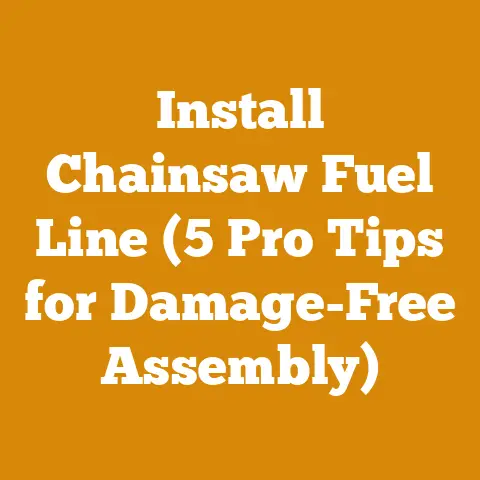High Track vs Low Track Dozers in Logging (5 Key Wood Harvesting Insights)
Alright, let’s dive into the wild world of dozers!
Ever feel like choosing the right piece of equipment is like picking the right axe for the job – crucial, but potentially head-scratching? I get it. I once tried to split oak with a dull hatchet. Let’s just say it involved more sweat than success and taught me a valuable lesson about matching the tool to the task. Today, we’re tackling a similar conundrum in the logging industry: high track versus low track dozers. It’s a question that can significantly impact your wood harvesting efficiency, safety, and overall profitability. So, buckle up, because we’re about to get down and dirty with some serious earthmoving machinery!
High Track vs. Low Track Dozers in Logging: 5 Key Wood Harvesting Insights
The logging industry is constantly evolving, and choosing the right equipment can make or break your operation. In 2023, the global logging market was valued at approximately $800 billion USD, with a projected annual growth rate of 3-5% over the next five years. This growth is driven by increasing demand for timber and wood products, but it also brings challenges such as stricter environmental regulations and the need for more efficient and sustainable harvesting practices. One area where informed decisions can lead to significant improvements is in the selection of dozers.
1. Understanding the Basics: What are High Track and Low Track Dozers?
Before we get into the nitty-gritty, let’s define what we’re talking about. Both high track and low track dozers are powerful machines used for pushing, grading, and clearing land. The primary difference lies in the position of the final drive and idler wheel relative to the tracks.
-
Low Track Dozers: In a low track dozer, the final drive and idler wheel are positioned lower, closer to the ground. This design has been around for a long time and is considered the traditional configuration.
-
High Track Dozers: As the name suggests, high track dozers have a raised final drive and idler wheel. This design, popularized by Caterpillar with their “Elevated Sprocket” design, offers several advantages in certain applications.
To put it simply, the height of the track matters. It affects everything from maneuverability to maintenance. It’s like the difference between using a maul and a splitting axe – both can split wood, but one is better suited for certain types of logs.
2. Key Differences and Performance Characteristics
Let’s break down the key differences between these two types of dozers and how they impact performance in logging operations:
2.1. Ground Clearance and Maneuverability
- Low Track Dozers: Offer lower ground clearance due to the position of the final drive. This can be a limitation in rough terrain with stumps, rocks, and debris. Maneuverability is generally good in open areas.
- High Track Dozers: Provide significantly higher ground clearance, allowing them to navigate over obstacles with greater ease. This is a major advantage in heavily forested areas with uneven terrain.
Data Point: A typical low track dozer might have a ground clearance of 12-18 inches, while a high track dozer can offer 20-25 inches or more.
My Experience: I remember one particularly challenging logging project in the Appalachian Mountains. We were using low track dozers, and it felt like we were constantly getting hung up on rocks and stumps. The downtime was killing our productivity. If we had used high track dozers, we could have avoided a lot of those headaches.
2.2. Traction and Stability
- Low Track Dozers: Generally offer excellent traction due to the longer track length in contact with the ground. Stability is good on relatively flat surfaces.
- High Track Dozers: May have slightly less traction in certain conditions due to the shorter track length in contact with the ground. However, the elevated final drive helps to reduce stress on the drivetrain, improving overall reliability. Stability is generally good, especially with wider track options.
Data Point: Low track dozers can achieve a drawbar pull of 80-90% of their weight, while high track dozers typically achieve 75-85%. This difference is often negligible in real-world logging applications.
Insight: While the drawbar pull might be slightly lower for high track dozers, the increased uptime and reduced maintenance costs often outweigh this difference.
2.3. Maintenance and Durability
- Low Track Dozers: The lower position of the final drive makes it more susceptible to damage from impacts and debris. Maintenance can be more frequent and costly.
- High Track Dozers: The elevated final drive is less exposed to impacts, reducing the risk of damage. This can lead to lower maintenance costs and increased uptime.
Data Point: Studies have shown that high track dozers can have up to 20-30% lower undercarriage maintenance costs compared to low track dozers in harsh logging environments.
Case Study: A logging company in British Columbia, Canada, switched from low track to high track dozers for their operations in mountainous terrain. They reported a 25% reduction in undercarriage repairs and a 15% increase in machine availability within the first year.
2.4. Operator Comfort
- Low Track Dozers: The ride can be rougher, especially in uneven terrain, due to the lower suspension travel.
- High Track Dozers: Often provide a smoother ride due to the elevated final drive and improved suspension design. This can reduce operator fatigue and improve productivity.
My Observation: A comfortable operator is a productive operator. I’ve seen firsthand how operator fatigue can lead to mistakes and reduced efficiency. A smoother ride can make a big difference over a long shift.
3. Choosing the Right Dozer for Your Logging Operation: A Step-by-Step Guide
Now that we’ve covered the key differences, let’s get down to the practical aspects of choosing the right dozer for your logging operation. Here’s a step-by-step guide:
Step 1: Assess Your Terrain
The type of terrain you’ll be working in is the most critical factor in determining whether a high track or low track dozer is the better choice.
- Rough, Uneven Terrain with Stumps, Rocks, and Debris: High track dozers are generally the preferred choice due to their superior ground clearance and maneuverability.
- Relatively Flat, Open Terrain with Few Obstacles: Low track dozers can be a cost-effective option, offering good traction and stability.
- Steep Slopes and Inclines: Both types of dozers can be used on slopes, but high track dozers may offer better stability due to their lower center of gravity. However, always prioritize safety and follow manufacturer’s recommendations for maximum slope ratings.
Actionable Tip: Conduct a thorough site assessment before making any decisions. Walk the land, identify potential obstacles, and consider the overall terrain conditions.
Step 2: Consider Your Primary Application
What will you be using the dozer for primarily?
- Road Building and Site Preparation: Both types of dozers can be used for road building, but high track dozers may be more efficient in clearing obstacles and grading uneven terrain.
- Skidding and Log Handling: Low track dozers can be suitable for skidding logs in open areas, but high track dozers offer better maneuverability in tight spaces and around obstacles.
- Land Clearing and Brush Removal: High track dozers are generally preferred for land clearing due to their ability to navigate over debris and push through thick brush.
My Insight: I’ve found that having a dozer that can handle multiple tasks is a huge advantage. It allows you to be more flexible and adapt to changing conditions.
Step 3: Evaluate Your Budget
The initial purchase price of a dozer is a significant investment, but it’s important to consider the total cost of ownership, including maintenance, fuel, and repairs.
- Low Track Dozers: Generally have a lower initial purchase price compared to high track dozers.
- High Track Dozers: May have a higher initial purchase price, but lower maintenance costs and increased uptime can offset this difference over the long term.
Cost Breakdown: A new low track dozer in the 200-horsepower range might cost $300,000 – $400,000, while a comparable high track dozer could cost $400,000 – $500,000. However, undercarriage repairs on a low track dozer in a harsh logging environment can easily cost $20,000 – $30,000 per year, while a high track dozer might only require $10,000 – $15,000 in undercarriage repairs.
Budgeting Tip: Create a detailed spreadsheet to compare the total cost of ownership for both types of dozers over a five-year period. Include factors such as purchase price, maintenance costs, fuel consumption, and potential downtime.
Step 4: Research and Compare Models
Once you’ve narrowed down your options, it’s time to do some research and compare specific models from different manufacturers.
- Read Reviews and Testimonials: Look for reviews from other loggers and industry professionals. Get their feedback on performance, reliability, and maintenance.
- Visit Dealerships and Test Drive Machines: Schedule test drives with different models to get a feel for their handling and performance.
- Compare Specifications: Pay close attention to specifications such as engine horsepower, operating weight, ground clearance, and track length.
Actionable Tip: Don’t be afraid to ask questions. Talk to dealership representatives, mechanics, and other loggers to get their insights and recommendations.
Step 5: Consider Used Equipment
Purchasing a used dozer can be a cost-effective way to acquire the equipment you need, but it’s important to do your due diligence.
- Inspect the Machine Thoroughly: Look for signs of wear and tear, damage, and previous repairs. Pay close attention to the undercarriage, engine, and hydraulics.
- Get a Professional Inspection: Hire a qualified mechanic to inspect the machine and provide a detailed report.
- Check the Maintenance Records: Review the maintenance records to see how well the machine has been maintained.
- Negotiate the Price: Don’t be afraid to negotiate the price based on the condition of the machine and the current market value.
My Advice: Buying used equipment can be a great way to save money, but it’s crucial to do your homework. A thorough inspection can save you from costly surprises down the road.
4. Optimizing Dozer Performance in Logging
Choosing the right dozer is only the first step. To maximize productivity and minimize costs, it’s essential to optimize dozer performance in your logging operation.
4.1. Proper Operator Training
A well-trained operator can significantly improve dozer performance and reduce the risk of accidents.
4.2. Regular Maintenance and Inspections
Regular maintenance and inspections are crucial for preventing breakdowns and extending the life of your dozer.
- Follow the Manufacturer’s Recommendations: Follow the manufacturer’s recommendations for maintenance intervals and procedures.
- Perform Daily Pre-Shift Inspections: Conduct daily pre-shift inspections to identify potential problems before they escalate.
- Keep Detailed Maintenance Records: Maintain detailed maintenance records to track repairs and identify recurring issues.
Maintenance Checklist: A typical daily pre-shift inspection should include checking fluid levels (engine oil, coolant, hydraulic fluid), inspecting tires or tracks for damage, checking lights and signals, and lubricating moving parts.
4.3. Efficient Work Practices
Efficient work practices can help to minimize fuel consumption, reduce wear and tear, and improve overall productivity.
- Plan Your Work Carefully: Plan your work carefully to minimize unnecessary travel and backtracking.
- Use the Right Gear for the Job: Use the right gear for the job to avoid overworking the engine and drivetrain.
- Avoid Overloading the Dozer: Avoid overloading the dozer, as this can lead to increased fuel consumption and premature wear.
- Minimize Idling Time: Minimize idling time to conserve fuel and reduce emissions.
Actionable Tip: Implement a fuel management program to track fuel consumption and identify areas for improvement.
4.4. Environmental Considerations
Logging operations can have a significant impact on the environment. It’s important to implement practices that minimize environmental damage and promote sustainability.
- Minimize Soil Disturbance: Minimize soil disturbance by using appropriate techniques and equipment.
- Protect Water Resources: Protect water resources by implementing erosion control measures and avoiding logging near streams and rivers.
- Replant Trees: Replant trees to ensure the long-term sustainability of the forest.
Best Practice: Implement a Best Management Practices (BMP) plan to address environmental concerns and comply with regulatory requirements.
5. Troubleshooting Common Dozer Problems in Logging
Even with proper maintenance and operation, dozers can experience problems in the demanding environment of logging. Here’s a troubleshooting guide to help you address some common issues:
5.1. Engine Problems
- Problem: Engine won’t start.
- Possible Causes: Low fuel, dead battery, faulty starter, clogged fuel filter.
- Troubleshooting Steps: Check fuel level, test battery, check starter connections, replace fuel filter.
- Problem: Engine overheats.
- Possible Causes: Low coolant, clogged radiator, faulty thermostat, broken water pump.
- Troubleshooting Steps: Check coolant level, clean radiator, replace thermostat, replace water pump.
- Problem: Engine runs rough.
- Possible Causes: Dirty air filter, faulty spark plugs, fuel injector problems.
- Troubleshooting Steps: Replace air filter, replace spark plugs, clean or replace fuel injectors.
5.2. Hydraulic Problems
- Problem: Hydraulic system is slow or weak.
- Possible Causes: Low hydraulic fluid, clogged hydraulic filter, faulty hydraulic pump, leaking hydraulic cylinder.
- Troubleshooting Steps: Check hydraulic fluid level, replace hydraulic filter, replace hydraulic pump, repair or replace hydraulic cylinder.
- Problem: Hydraulic system leaks.
- Possible Causes: Damaged hoses, loose fittings, worn seals.
- Troubleshooting Steps: Replace damaged hoses, tighten loose fittings, replace worn seals.
5.3. Undercarriage Problems
- Problem: Tracks are loose or slipping.
- Possible Causes: Worn track links, worn sprockets, loose track adjuster.
- Troubleshooting Steps: Replace worn track links, replace worn sprockets, adjust track tension.
- Problem: Tracks are damaged or broken.
- Possible Causes: Impacts with rocks or stumps, excessive wear, improper track tension.
- Troubleshooting Steps: Repair or replace damaged track links, adjust track tension.
Actionable Tip: Keep a well-stocked toolbox with essential tools and spare parts to address common problems in the field.
Next Steps and Additional Resources
Choosing the right dozer for your logging operation is a critical decision that can significantly impact your productivity, profitability, and sustainability. By carefully assessing your terrain, considering your primary application, evaluating your budget, and optimizing dozer performance, you can make an informed decision and achieve your logging goals.
Additional Resources:
- Logging Equipment Suppliers:
- Caterpillar: https://www.cat.com/
- John Deere: https://www.deere.com/
- Komatsu: https://www.komatsu.com/
- Logging Associations:
- Society of American Foresters: https://www.eforester.org/
- National Hardwood Lumber Association: https://nhla.com/
- Equipment Rental Services:
- Sunbelt Rentals: https://www.sunbeltrentals.com/
- United Rentals: https://www.unitedrentals.com/
Remember, the right dozer is just one piece of the puzzle. Success in logging requires careful planning, skilled operators, and a commitment to sustainable practices. Now, go out there and make some sawdust!






